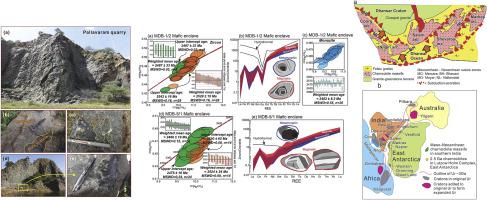Gondwana Research ( IF 7.2 ) Pub Date : 2021-03-09 , DOI: 10.1016/j.gr.2021.03.003 Cheng-Xue Yang , M. Santosh , T. Tsunogae , E. Shaji , Pin Gao , Sanghoon Kwon

|
The global ‘type area’ charnockites and those in the surrounding localities within Madras block of the Southern Granulite Terrane in India dominantly comprise felsic to intermediate, coarse to medium grained, orthopyroxene-bearing anhydrous granulite facies rocks with sporadic garnet. In several localities, the charnockitic suite contains mafic magmatic enclaves of gabbroic to dioritic composition showing calcic and peraluminous composition. The charnockite suite shows compositional range from monzonite through granodiorite to granite, and are calcic and calc-alkalic, peraluminous, including both magnesian and ferroan types. Their major and trace element variations are consistent with progressive magmatic differentiation. The charnockites show high Ba-Sr content with a trend from normal arc-related rocks to adakites. The geochemical features of the charnockites and mafic enclaves are consistent with subduction-related arc setting, and slab-derived magmas interacting with mantle wedge peridotite. The P-T conditions as estimated through mineral phase equilibria modelling and pseudosection computations of representative charnockite and mafic enclave samples show a range of ca. 7 to 9 kbar and 870 to 960 °C, suggesting high- to ultra-high temperature granulite facies conditions during the peak metamorphism.
The zircon grains from the charnockites show magmatic features with oscillatory or banded zoning, and in many cases display core-rim structure indicating dissolution and metamorphic overgrowth. The magmatic grains/domains show typical steep LREE to HREE pattern, whereas the metamorphic domains show relatively flat HREE. Magmatic zircon U-Pb data indicate crystallization ages of ca. 2.53 Ga to 2.57 Ga. The identical age from magmatic zircon grains in the mafic enclaves suggests bimodal magmatism with underplated mafic magmas intruding into the felsic magma chamber. The U-Pb data from metamorphic zircon and monazite indicate that all the rocks were metamorphosed coevally at ca. 2.47 Ga to 2.49 Ga, soon after their emplacement. The close timing between magmatism and metamorphism of ca. 40 Myr also suggests the formation of the magmatic suite along an active convergent margin, followed by collisional metamorphism during the termination of subduction and ocean closure. The Lu-Hf analyses of magmatic domains in zircon show mostly positive ɛHf(t) values up to +8.7, with only a few spots showing slightly negative values up to −0.8. Zircon grains in the mafic enclaves also show mostly positive ɛHf(t) values up to +4.3. The U-Pb-Hf data are consistent with juvenile arc building during late Neoarchean, with no significant older components. Together with the Hf model ages, the data indicate that the magmas were derived from depleted mantle components of Meso- to Neoarchean age, which would suggest an active subduction regime that continued until the ocean closure during end Neoarchean-earliest Paleoproterozoic. The granulite blocks surrounding the southern margin of the Dharwar craton including the Madras block are interpreted as multiple arcs that coalesced and accreted onto the craton during the Neoarchean-Paleoproterozoic transition. These blocks, which are dominated by charnockites and ranging in age from Mesoarchean to late Neoarchean, and their equivalents in other cratonic fragments over the globe, can be correlated to the ‘expanded Ur’, in building the oldest supercontinent on Earth.
中文翻译:

重新探讨印度南部的全球型地区蛇怪石:对地球上最古老的超大陆的启示
全球“类型区”砂岩和印度南部花岗岩田地马德拉斯地块周围地区的那些,主要由长英质到中粒,粗粒至中粒,含邻二甲苯的无水粒状岩相组成,有散在的石榴石。在几个地方,夏尼科特岩层包含镁铁质岩浆岩辉辉岩到闪长岩的飞地,表现出钙质和高铝质的成分。硫霞石组的成分范围从单长石到花岗闪长岩再到花岗岩,并且钙质和钙质碱金属呈钙质,包括镁质和亚铁质类型。它们的主要和微量元素变化与渐进的岩浆分异一致。菱锰矿显示出高的Ba-Sr含量,并且具有从正常的弧相关岩石到Adakite的趋势。夏洛岩和镁铁质飞地的地球化学特征与俯冲相关的弧定形,板状岩浆与地幔楔形橄榄岩相互作用是一致的。通过矿物相平衡模型和代表性的菱镁矿和镁铁质飞地样品的伪截面计算估算的PT条件显示范围约为。7至9 kbar和870至960°C,表明在峰值变质过程中出现了高温至超高温的花岗石相条件。
菱镁矿中的锆石颗粒显示出具有振荡或带状带的岩浆特征,并且在许多情况下显示出核心-边缘结构,表明溶解和变质的过度生长。岩浆晶粒/畴显示出典型的陡峭的从REE到HREE的模式,而变质畴显示出相对平坦的HREE。岩浆锆石的U-Pb数据表明约有大约50年的结晶年龄。2.53 Ga至2.57 Ga。镁铁质飞地中岩浆锆石晶粒的年龄相同,这表明双峰岩浆活动,底层的镁铁质岩浆侵入到长岩浆岩浆室中。来自变质锆石和独居石的U-Pb数据表明,所有岩石在ca. 进位后不久,从2.47 Ga到2.49 Ga。Ca的岩浆作用与变质作用的密切时机。40 Myr还建议沿着活跃的会聚边缘形成岩浆组,然后在俯冲和海洋封闭终止期间发生碰撞变质作用。锆石岩浆区域的Lu-Hf分析显示,mostlyHf(t)值大多为正值,最高为+8.7,只有几个点显示为负值,最高为-0.8。镁铁质飞地中的锆石晶粒也显示出最多为+4.3的正fHf(t)值。U-Pb-Hf数据与新archarean晚期的幼弧形成一致,没有明显的较旧成分。连同Hf模型年龄,数据表明这些岩浆来自中到新古纪时代的贫化地幔成分,这表明活跃的俯冲作用一直持续到新古纪末最早的元古生代末期的大洋封闭。Dharwar克拉通南缘周围的花岗石块(包括Madras块)被解释为在新古构造时代至古生代过渡期聚结并聚集到克拉通上的多条弧线。这些由夏洛克人统治的块体,年龄从中古构造时代到新新世晚期,以及它们在全球其他克拉通碎块中的等价物,都可以与“膨胀的乌尔”相关联,以建造地球上最古老的超大陆。











































 京公网安备 11010802027423号
京公网安备 11010802027423号